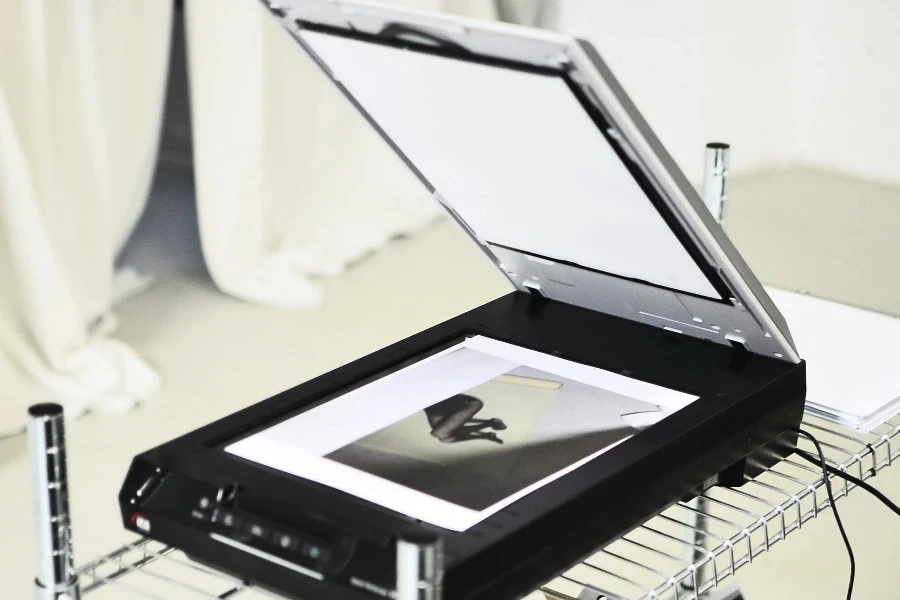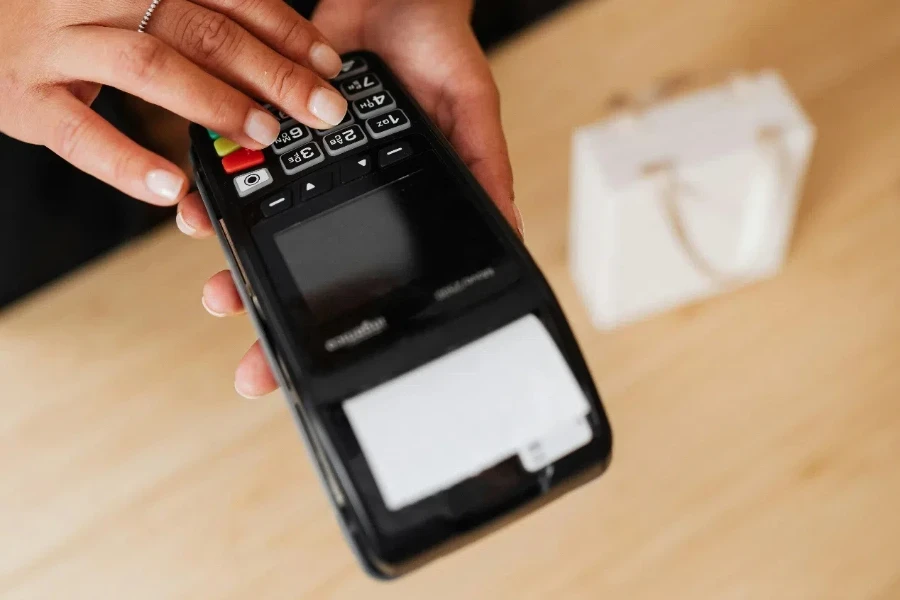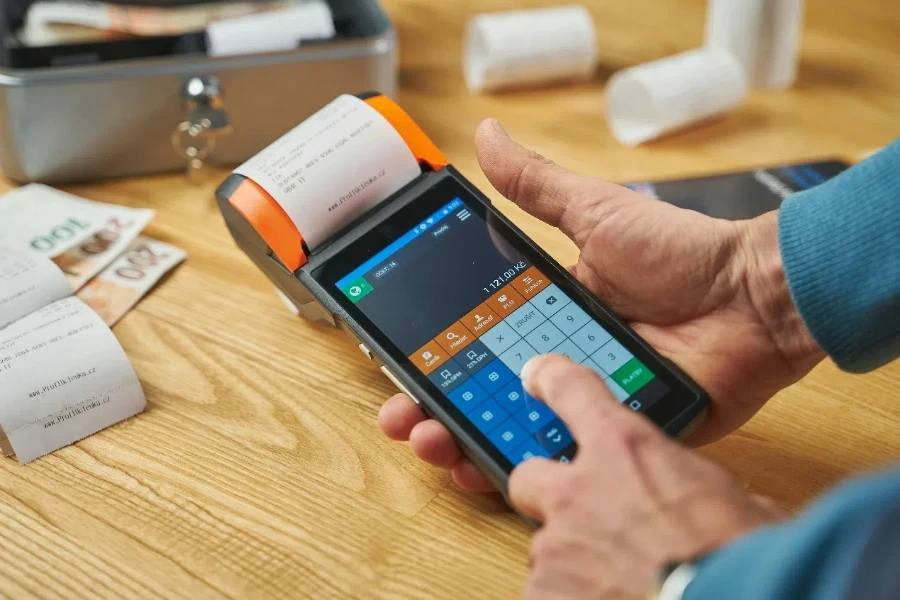Recent trends highlight the increasing need for efficient financial management tools in 2025. This comprehensive guide delves into the market size, key growth factors, and regional analysis of receipt scanners. It provides professional buyers with valuable insights into essential features, cost-benefit ratios, and technological advancements in receipt scanning. The article aims to assist in making informed purchasing decisions to enhance financial management processes.
Table of Contents:
Market Overview: Booming Industry with Promising Growth
In-Depth Analysis: Key Drivers and Market Dynamics
Key Factors to Consider When Selecting Receipt Scanners for Financial Management
Advanced Features in Modern Receipt Scanners for Financial Management
Evaluating the Durability and Build Quality of Receipt Scanners
Customer Support and After-Sales Service for Receipt Scanners
Market Overview: Booming Industry with Promising Growth

The global market for receipt scanners is experiencing strong growth due to the increasing need for efficient financial management tools. As of 2024, the market is valued at approximately $2.6 billion and is projected to reach $3.0 billion by 2030, growing at a compound annual growth rate (CAGR) of 2.4%. This growth is driven by advancements in digital payment systems and the rising adoption of modern point-of-sale (POS) solutions.
Thermal receipt printers, a key segment within this market, are expected to grow significantly. The market for thermal receipt printers alone is projected to reach $14.48 billion by 2029, with a CAGR of 9.5% from 2023. Their efficiency, cost-effectiveness, and eco-friendly nature contribute to this surge, aligning with the global shift towards sustainable business practices.
Regionally, North America holds the largest market share, supported by a mature retail sector and technological innovation. The U.S. market was estimated at $694.9 million in 2023, with China’s market expected to grow at a CAGR of 3.7% to reach $569.6 million by 2030. The Asia-Pacific region also shows significant potential, with countries like India and Japan contributing to the market’s expansion.
In-Depth Analysis: Key Drivers and Market Dynamics

Technological Advancements and Integration
Technological advancements are significantly enhancing receipt scanners. Modern scanners now offer faster scanning speeds, higher resolution outputs, and seamless integration with various business management systems. Wireless and Bluetooth connectivity options enable flexible and mobile transaction solutions, catering to the demand for mobile POS systems.
The integration of receipt scanners with cloud-based POS systems is a notable trend. These solutions offer real-time data management, inventory tracking, and customer relationship management (CRM) functionalities. This integration improves operational efficiency and provides valuable insights for strategic decision-making. For instance, the adoption of cloud-based POS systems has led to increased demand for thermal receipt printers, which suit modern setups.
Market Segmentation and Consumer Behavior
The receipt scanner market can be segmented by technology, end-user, and region. Key technologies include direct thermal, thermal transfer, and dye diffusion thermal transfer printers. Direct thermal printers dominate the market due to their simplicity and lower operational costs. They are widely used in retail, hospitality, and logistics sectors, where cost-effective and efficient printing solutions are crucial.
Consumer behavior is shifting towards eco-friendly and energy-efficient solutions. Both businesses and consumers prioritize sustainability, driving demand for thermal receipt printers that do not require ink or toner. This trend aligns with the broader push for greener technologies and reduced carbon footprints. Additionally, modern receipt printers offer customization and branding options, such as logos and promotional messages, enhancing brand visibility and customer engagement.
Distribution Channels and Economic Influences
Receipt scanners are distributed through both online and offline platforms. Online sales channels are gaining traction due to their convenience and wider reach. However, offline channels, including direct sales and retail stores, remain significant, especially in regions with less digital penetration.
Economic influences, such as the rise of the gig economy and e-commerce, are also driving market growth. The need for efficient transaction systems in these sectors boosts demand for portable and reliable receipt scanning solutions. Additionally, regulatory requirements for transaction records and documentation in various industries further propel the market.
Challenges and Opportunities
The receipt scanner market faces challenges such as competition from digital receipts and the trend towards paperless transactions. The increasing adoption of mobile payment systems and e-wallets reduces reliance on printed receipts, posing a threat to traditional receipt scanners.
However, opportunities lie in continuous innovation and technological integration. Investing in research and development to enhance the functionality and connectivity of receipt scanners can help businesses stay competitive. The focus on sustainability and energy efficiency also presents growth opportunities, as businesses strive to align with environmental goals and consumer preferences.
Key Factors to Consider When Selecting Receipt Scanners for Financial Management

Choosing the right receipt scanner for financial management involves evaluating various critical factors. Each can significantly impact the efficiency, accuracy, and overall performance of the scanner. Below are essential considerations to keep in mind:
Scanner Types and Styles
Receipt scanners come in different types and styles, each designed to meet specific needs. The most common include portable scanners, desktop scanners, and mobile app-based scanners. Portable scanners are lightweight and easy to carry, ideal for professionals on the go. Desktop scanners offer higher speed and volume capabilities, suitable for office environments with high scanning demands. Mobile app-based scanners leverage smartphone cameras to capture receipts, providing a convenient solution for casual users.
Consider the volume of receipts you need to process daily. For instance, a portable scanner with a speed of 10 pages per minute (ppm) might suffice for individual use, but a desktop scanner with a speed of 40 ppm would be more appropriate for a busy office. Also, check the scanner’s compatibility with various receipt sizes and types, such as thermal paper receipts, commonly used in retail.
Performance and Functionality
The performance and functionality of a receipt scanner are crucial to its effectiveness in financial management. Key indicators include scanning speed, resolution, and optical character recognition (OCR) capabilities. High-resolution scanners (600 dpi or more) ensure that even the smallest details on receipts are captured accurately. OCR technology converts scanned images into editable and searchable text, streamlining data entry.
Advanced scanners offer features such as duplex scanning, allowing for simultaneous scanning of both sides of a receipt, and automatic document feeders (ADF) that can handle multiple receipts at once. These features reduce manual intervention and increase productivity. For example, a scanner with an ADF capacity of 50 sheets can process bulk receipts efficiently, saving time and effort.
Design and Aesthetics
While functionality is crucial, the design and aesthetics of a receipt scanner should not be overlooked. A well-designed scanner that fits seamlessly into your workspace can enhance user experience and productivity. Consider scanners with compact and ergonomic designs that occupy minimal desk space and are easy to handle. Sleek and modern aesthetics can also complement office decor, creating a professional and organized appearance.
The build quality of the scanner is important for durability and longevity. Scanners made from high-quality materials, such as reinforced plastics and metal components, are more likely to withstand frequent use and resist wear and tear. For example, a scanner with a robust build and a weight of around 3 pounds can offer both portability and durability.
Price Range and Budget
The price range of receipt scanners varies widely, from affordable options under $100 to high-end models exceeding $500. When setting a budget, consider the features and capabilities most important for your financial management needs. Entry-level scanners may offer basic functionalities like single-side scanning and lower resolution, suitable for occasional use. In contrast, premium models provide advanced features such as high-speed scanning, duplex capabilities, and superior OCR accuracy, justifying their higher price tag.
Factor in additional costs, such as software subscriptions or maintenance fees. Some scanners come with bundled software for receipt management, while others may require separate purchases. Evaluate the total cost of ownership to ensure the scanner fits within your budget without compromising on essential features.
Compatibility and Integration
Compatibility with existing systems and integration with financial management software is a critical consideration. Ensure the receipt scanner supports various operating systems, such as Windows, macOS, and Linux, to avoid compatibility issues. Check if the scanner can seamlessly integrate with popular accounting and expense management software like QuickBooks, Xero, and Expensify.
Integration capabilities can streamline workflows by automatically importing scanned data into financial management systems, reducing manual data entry and minimizing errors. For instance, a scanner that offers direct integration with cloud storage services like Google Drive and Dropbox can facilitate easy access and sharing of scanned receipts, enhancing collaboration and efficiency.
Advanced Features in Modern Receipt Scanners for Financial Management

Modern receipt scanners are equipped with advanced features that enhance functionality and user experience. These features cater to the evolving needs of businesses and individuals managing financial records.
Cloud Connectivity and Storage
Cloud connectivity is a significant advancement in receipt scanners, allowing users to store and access scanned receipts from anywhere with an internet connection. Scanners with built-in Wi-Fi or Bluetooth enable direct uploading to cloud services such as Google Drive, Dropbox, and OneDrive. This feature ensures receipts are securely backed up and easily retrievable, facilitating remote work and collaboration.
For example, a receipt scanner with cloud connectivity can automatically sync scanned receipts to a designated cloud folder, providing real-time access to financial records. This capability is beneficial for businesses with distributed teams or remote employees who need to share and review receipts promptly.
Enhanced OCR and AI Capabilities
The integration of artificial intelligence (AI) and enhanced optical character recognition (OCR) capabilities has revolutionized receipt scanning. AI-powered scanners can intelligently recognize and categorize receipt information, such as vendor names, transaction dates, and amounts, reducing the need for manual data entry. Advanced OCR technology ensures high accuracy in text recognition, even on faded or damaged receipts.
Some scanners also offer machine learning algorithms that improve accuracy over time by learning from user corrections. For instance, if a scanner misinterprets a specific vendor name, the user can correct it, and the scanner will remember this correction for future scans, enhancing efficiency and accuracy.
Multi-Currency and Multi-Language Support
As businesses operate globally, multi-currency and multi-language support have become essential features in receipt scanners. Scanners that can recognize and process receipts in multiple currencies and languages cater to international transactions and diverse clientele. This capability simplifies financial management for businesses with global operations, ensuring receipts are accurately recorded and categorized regardless of their origin.
For example, a scanner with multi-currency support can automatically convert foreign currency amounts to the user’s preferred currency, streamlining expense reporting and accounting processes. Multi-language support ensures receipts in different languages are accurately interpreted, reducing the risk of errors and discrepancies.
Evaluating the Durability and Build Quality of Receipt Scanners

The durability and build quality of receipt scanners are crucial factors that influence their longevity and reliability. High-quality scanners are designed to withstand frequent use and harsh environments, ensuring consistent performance over time.
Material Composition and Construction
Receipt scanners constructed from durable materials, such as reinforced plastics and metal components, are more resilient to wear and tear. The material composition directly impacts the scanner’s ability to endure physical stress and maintain functionality. Scanners with metal frames and robust plastic casings offer a balance of strength and portability, making them suitable for both office and field use.
For instance, a scanner with an aluminum frame and high-impact plastic components can withstand drops and impacts, ensuring it remains operational even in challenging conditions. Additionally, scanners with dust and moisture-resistant features are ideal for use in environments where exposure to contaminants is a concern.
Product Lifespan and Warranty
The expected lifespan of a receipt scanner is an important consideration, especially for businesses that rely on consistent performance. High-quality scanners typically have a longer lifespan, reducing the need for frequent replacements and minimizing downtime. Manufacturers often provide warranty coverage that reflects their confidence in the product’s durability.
A receipt scanner with a three-year warranty, for example, indicates the manufacturer’s assurance of its longevity and reliability. Extended warranties and service plans can also offer peace of mind, covering repairs and replacements in case of defects or malfunctions. Evaluating the warranty terms and conditions can help determine the scanner’s overall value and reliability.
Reliability in Extreme Conditions
For businesses operating in extreme conditions, such as outdoor environments or industrial settings, the reliability of receipt scanners is paramount. Scanners designed to function in a wide range of temperatures and humidity levels ensure consistent performance regardless of environmental factors. Features such as shock-absorbing components and ruggedized designs enhance the scanner’s ability to withstand harsh conditions.
For example, a scanner rated to operate in temperatures ranging from -10°C to 50°C can handle both cold and hot environments without compromising performance. Scanners with IP ratings for dust and water resistance are also suitable for use in dusty or wet conditions, ensuring they remain functional and reliable.
Customer Support and After-Sales Service for Receipt Scanners

Effective customer support and after-sales service are essential for ensuring a positive user experience with receipt scanners. Reliable support can address technical issues, provide guidance on usage, and facilitate repairs or replacements.
Technical Support and Troubleshooting
Access to technical support is crucial for resolving any issues that may arise with receipt scanners. Manufacturers that offer comprehensive technical support through various channels, such as phone, email, and live chat, ensure users can quickly receive assistance. Detailed user manuals, online tutorials, and FAQs also provide valuable resources for troubleshooting common problems.
For example, a manufacturer with a dedicated support team available 24/7 can promptly address technical issues, minimizing downtime and ensuring the scanner remains operational. Providing remote assistance and software updates further enhances the user experience, keeping the scanner up-to-date with the latest features and improvements.
Return and Refund Policies
Clear and fair return and refund policies are important considerations when purchasing receipt scanners. These policies provide assurance that users can return or exchange the product if it does not meet their expectations or has defects. Understanding the terms and conditions of the return policy, including the time frame for returns and any associated fees, helps users make informed decisions.
A receipt scanner with a 30-day return policy and a full refund option, for example, offers flexibility and confidence in the purchase. Additionally, manufacturers that facilitate easy and hassle-free returns enhance customer satisfaction and loyalty.
Warranty and Repair Services
Warranty coverage and repair services are critical for maintaining the functionality and longevity of receipt scanners. Manufacturers that offer comprehensive warranty coverage, including parts and labor, demonstrate their commitment to product quality. Access to authorized repair centers ensures any necessary repairs are performed by qualified technicians using genuine parts.
For instance, a manufacturer that provides a two-year warranty with optional extended coverage offers long-term protection for the scanner. Offering loaner units during repair periods can also minimize disruption to business operations, ensuring users have continuous access to receipt scanning capabilities.
Wrapping Up
Choosing the right receipt scanner involves considering various factors, including scanner types, performance, design, price, compatibility, durability, and customer support. By carefully evaluating these aspects, you can select a scanner that meets your financial management needs and enhances productivity.



